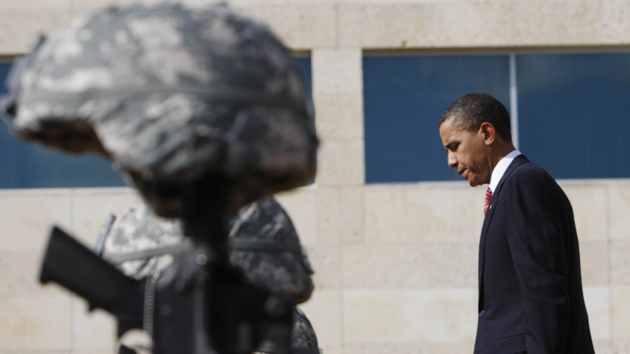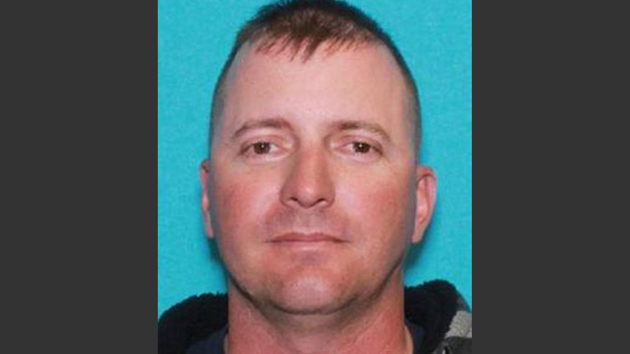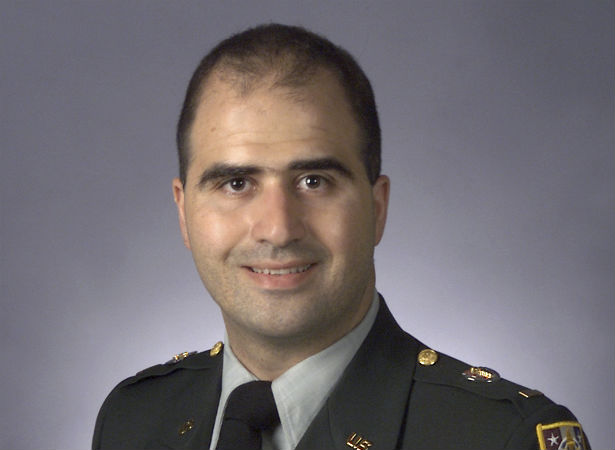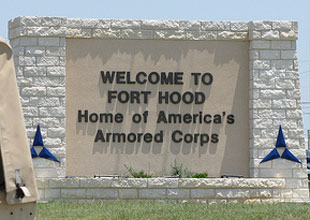
Pablo Martinez Monsivais/AP
Just after last week’s shooting rampage at Fort Hood, President Barack Obama made a simple promise to survivors: “We are going to do everything we can to make sure the community at Fort Hood has what it needs to deal with the current situation, but also any potential aftermath.” For victims of the previous attack on Fort Hood in 2009, these words were a bitter reminder of the empty assurances they received from the Army and Obama administration officials, who pledged to take care of them and their families after the shooting. Retired Army Staff Sgt. Shawn Manning, who was shot six times and nearly suffocated on his own blood, recalls then-Secretary of Defense Robert Gates handing his wife a business card and saying, “If you ever need anything, call me.” And yet, in the years since Maj. Nidal Hasan opened fire in a crowded medical center, leaving 13 people dead and 32 wounded, survivors have struggled to obtain medical care, psychiatric treatment, and financial benefits. “Five years later, we’re still fighting,” Manning says. “Every time we get our hopes up, we run into another road block.”
Survivors of last week’s attack will likely face similar challenges. Under military rules, soldiers wounded in combat or terrorist attacks are supposed to receive a raft of benefits, including tax breaks, compensation, and special medical services. So are the families of those killed in action. But the Army doesn’t consider either of the Fort Hood shootings to be combat or terrorism related. Although Hasan is an avowed jihadist with links to Al Qaeda, the Pentagon labeled that incident “workplace violence”—a term that seems more fitting for last week’s attack based on the sketchy details that have emerged about the alleged shooter, Spc. Ivan Lopez.
The decision to brand the event workplace violence has had profound consequences for survivors of the first Fort Hood shooting, many of whom say they’ve had difficulty providing for themselves and obtaining medical care due to the lack of benefits. (The Army declined to answer questions about specific services victims allege they were denied, but in a written statement to Mother Jones said that it “provides emergency treatment and long term access to care to all of our beneficiaries, regardless of the circumstances under which these injuries took place.” An Army spokeswoman also noted that the Fort Hood victims are eligible for a number of financial benefits, including life insurance and funeral allowances.) In late 2012, nearly 150 Fort Hood victims and their family members filed a lawsuit against the Department of Defense, accusing it of “reckless disregard” for the victims’ lives and emotional wellbeing. They’re seeking unspecified damages for their suffering and lost benefits.
Among the plaintiffs is former Army reservist Keara Bono-Torkelson, who was shot in the back by Hasan. She recalls the nurse at the Army hospital where she was rushed for treatment patting her on the head and telling her she was fine. Only weeks later, when she visited her family doctor in Missouri, did she discover that she also had a bullet lodged in her head.
With her injuries, Torkelson—who suffers from back spasms, PTSD, and crippling headaches—?found it difficult to do her job. Rather than send her to a special unit for wounded soldiers, as it usually does with reservists wounded in combat, the Army pulled her off active duty and sent her home. She says her paycheck subsequently shrank from $1,400 a month to roughly $200 and she lost her military health insurance, leaving her no access to medical care. ?
In 2010, after months of fighting the Army for treatment with mixed results, she reached out to Ross Perot, who has quietly helped other wounded soldiers with their medical expenses. The billionaire Texas businessman and former presidential contender paid for Torkelson to go to the Mayo Clinic, where doctors quickly pinpointed the source of her headaches: Besides the slug that had been removed from her scalp, she had multiple bullet fragments in her skull—something her military doctors could have detected with a simple x-ray.
The “workplace violence” label has also kept victims of the first Fort Hood attack from being honored for their heroism. Private First Class Amber Gadlin, who was 19 at the time, braved gunfire to drag other soldiers to safety, even after being shot in the back. During the 2009 Fort Hood memorial, the president praised her for her valor. But because of the way the shooting was classified, Gadlin isn’t eligible for awards, such as the Purple Heart, or the accompanying benefits, which include extra pay, priority access to medical care, and, in certain cases, free in-state tuition for the honorees’ children.
Gadlin, who says she can only sit for a half hour at a stretch because of severe back pain, scrapes by on her $1,400 a month disability payment from the Department of Veterans Affairs and has struggled to get treatment for her depression and PTSD. “Having to fight for benefits on top of the injuries and the money worries has made things far worse,” says her mother, Lisa Bahr Pfund. “There have been plenty of times I’ve been expecting a phone call saying she’s gone. Meaning, you know, she’s taken care of her problems permanently.”
Other survivors have similar stories. Retired Staff Sgt. Alonzo Lunsford, a 6-foot-9, 300-pound North Carolina resident, was shot seven times during the 2009 attack, including once in the head. Even as he lay bleeding in the parking lot with medics attending to his wounds, Hasan kept firing at him.
Several months after the incident, Lunsford tried to check into an Army PTSD clinic near El Paso. But he says he was turned away on the grounds that he wasn’t injured in combat. Eventually, Lunsford, who served in the Army for 22 years, managed to get into a Navy clinic in San Diego. The Army was supposed to pick up the tab. But instead, he says, it deducted most of the expenses from his paycheck.
Since the attack, Lunsford, who also received help from Perot, has retired because of his injuries—he’s missing half his intestines, is blind in one eye, and has trouble walking (a side effect of the bullet lodged in his thigh). He also suffers from bouts of debilitating pain. “Sometimes, I’m immobile in bed for a month,” he says. “I can’t even go to the bathroom by myself. My wife literally has to wipe me.”
If his wounds were classified as combat or terrorism related, he would get three quarters of his active-duty pay, on top of his modest VA disability payments, for the rest of his life. But as it stands, he isn’t eligible. Lunsford declined to give specific figures. But Sgt. Manning, whose wife received the business card from Secretary Gates, says he’s lost roughly $70,000 that he would have gotten if he were injured in a war zone. (Gates declined to comment for this story.) And he’ll continue to miss out on more than $700 each month for as long as he lives. “It’s bad enough having to go through a traumatic experience like this,” he says. “But to feel betrayed by the military you’ve served 13 years—it’s like dedicating your life to somebody, then having them turn their back on you.”
Several members of Congress have tried to remedy the problem—to no avail. Last May, Reps. Chaka Fattah (D-Pa.), Frank Wolf (R-Va.), and Thomas Rooney (R-Fla.) wrote a letter to Secretary of Defense Chuck Hagel, calling the government’s decision to classify the shooting as workplace violence an “irresponsible, indefensible breach of our nation’s sacred pledge to our service members.” The letter continued:
This designation has since resulted in an embarrassing lack of care and treatment by our military for the victims and their families. Therefore, we ask that you swiftly reclassify the victims’ deaths and injuries as “combat-related” so that they and their families may qualify for the full scope of benefits provided to service members and DoD civilian employees who are killed or injured in combat, and to ensure that they are treated with appropriate decency and respect from this point forward.
Since 2009, Rep. John Carter (R-Texas), whose district includes part of Fort Hood, has been promoting a bill and a string of amendments that would make victims of the first attack eligible for the same benefits and honors as soldiers killed or wounded in combat, including Purple Hearts. The stand-alone measure has garnered broad support, with more 200 co-sponsors. And a variation was included in the defense-spending bill that passed the House last year. But after the White House and the Army voiced opposition, it was stripped out of the Senate version in favor of language requiring the Pentagon to re-evaluate its rules for awarding medals. (The White House declined to comment for this story.) In a position paper leaked to ABC News last spring, the Army argued against awarding the 2009 victims Purple Hearts on the grounds that doing so could “be viewed as setting the stage for a formal declaration that Major Hasan is a terrorist.” This, in turn, would allow his lawyers to “argue that Major Hasan cannot receive a fair trial because a branch of government has indirectly declared that Major Hasan is a terrorist—that he is criminally culpable.”
The military has used a similar rationale to justify the workplace violence designation to victims and lawmakers. “The label was in keeping with what they thought was the best way to proceed with the case,” says Rep. Fattah, who pressed for reclassifying the incident. “What it left out of the equation was the effect on victims.” During Hasan’s Army court martial last August, the word terrorism was never uttered in the jury’s presence. And the judge refused to admit any evidence of Hasan’s jihadist ties, although Hasan testified that he had “switched sides” in what he called the war against Islam and had attacked his fellow soldiers to protect the Taliban from US forces.
Survivors of the first Fort Hood attack say military officials assured them repeatedly that they would receive additional benefits and honors after the trial was over. They also allege that the Army leaned on them not to speak publicly about their experiences, especially during Hasan’s court martial. Lunsford, the Army’s star witness, recalls prosecutor Col. Mike Mulligan threatening to lock him up and strike his testimony if he spoke to the press—even about issues unrelated to the case.
In its statement to Mother Jones, the Army denied issuing blanket gag orders and said victims were merely “cautioned that public statements could affect the anticipated court-martial.” Reed Rubinstein, a lawyer for the victims and their families, bristles at this claim. “The idea that these folks could somehow effect the deliberations of the jury by describing how the government has dumped on them for five years is absurd,” he says.
Many survivors suspect the real reason the Army has tried to keep them from speaking out is because details of the case could embarrass the Pentagon and the Obama administration. As Mother Jones has reported, law enforcement and intelligence officials had collected evidence of Hasan’s jihadist sympathies long before his shooting spree. Beginning in 2008, an FBI-led joint terrorism task force—which included military officials—intercepted more than a dozen emails between Hasan and Anwar al-Awlaki, a radical cleric associated with Al Qaeda who was killed in an American drone strike in 2011. Among other things, Hasan asked al-Awlaki whether he considered American military personnel who died attacking their fellow soldiers “shaheeds,” or martyrs, and whether “indiscriminately killing civilians” was acceptable. Former Sen. Joe Lieberman, who read Hasan’s file as part of a 2011 Senate investigation, expressed shock the FBI and Pentagon had failed to act on intelligence that “with the clarity of hindsight just shouts out, ‘Stop this guy before he kills somebody!'”
Now, Fort Hood is reeling from another tragedy. The two attacks differ in important ways. For one, there’s no indication that Lopez, the gunman behind the most recent shooting, which left three dead and 16 wounded, was a jihadist. But the long, painful journey of the 2009 victims may be a sign of what’s in store for survivors and families who are struggling to come to grips with last week’s bloodshed.
In the seven months since Hasan’s conviction on murder charges, many of his victims have given up hope of ever being made whole. “Some of the victims’ families kept their faith that government was going to fix all this when the trial was over—that their loved ones who were killed or wounded were going to get the recognition they should have gotten,” says Manning. “But the trial ended and nothing got fixed. We’ve been hung out to dry.”














